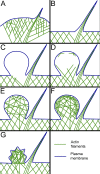Time-resolved ultrastructure of the cortical actin cytoskeleton in dynamic membrane blebs
- PMID: 30541746
- PMCID: PMC6363452
- DOI: 10.1083/jcb.201806075
Time-resolved ultrastructure of the cortical actin cytoskeleton in dynamic membrane blebs
Abstract
Membrane blebbing accompanies various cellular processes, including cytokinesis, apoptosis, and cell migration, especially invasive migration of cancer cells. Blebs are extruded by intracellular pressure and are initially cytoskeleton-free, but they subsequently assemble the cytoskeleton, which can drive bleb retraction. Despite increasing appreciation of physiological significance of blebbing, the molecular and, especially, structural mechanisms controlling bleb dynamics are incompletely understood. We induced membrane blebbing in human HT1080 fibrosarcoma cells by inhibiting the Arp2/3 complex. Using correlative platinum replica electron microscopy, we characterize cytoskeletal architecture of the actin cortex in cells during initiation of blebbing and in blebs at different stages of their expansion-retraction cycle. The transition to blebbing in these conditions occurred through an intermediate filopodial stage, whereas bleb initiation was biased toward filopodial bases, where the cytoskeleton exhibited local weaknesses. Different stages of the bleb life cycle (expansion, pausing, and retraction) are characterized by specific features of cytoskeleton organization that provide implications about mechanisms of cytoskeleton assembly and bleb retraction.
© 2019 Chikina et al.
Figures






Similar articles
-
Myosin II-interacting guanine nucleotide exchange factor promotes bleb retraction via stimulating cortex reassembly at the bleb membrane.Mol Biol Cell. 2018 Mar 1;29(5):643-656. doi: 10.1091/mbc.E17-10-0579. Epub 2018 Jan 10. Mol Biol Cell. 2018. PMID: 29321250 Free PMC article.
-
Transition from mesenchymal to bleb-based motility is predominantly exhibited by CD133-positive subpopulation of fibrosarcoma cells.Biol Cell. 2019 Oct;111(10):245-261. doi: 10.1111/boc.201800078. Epub 2019 Aug 22. Biol Cell. 2019. PMID: 31403697
-
A RhoA and Rnd3 cycle regulates actin reassembly during membrane blebbing.Proc Natl Acad Sci U S A. 2016 Mar 29;113(13):E1863-71. doi: 10.1073/pnas.1600968113. Epub 2016 Mar 14. Proc Natl Acad Sci U S A. 2016. PMID: 26976596 Free PMC article.
-
Membrane bleb: A seesaw game of two small GTPases.Small GTPases. 2017 Apr 3;8(2):85-89. doi: 10.1080/21541248.2016.1199266. Epub 2016 Jun 17. Small GTPases. 2017. PMID: 27314434 Free PMC article. Review.
-
A Clockwork Bleb: cytoskeleton, calcium, and cytoplasmic fluidity.FEBS J. 2022 Dec;289(24):7907-7917. doi: 10.1111/febs.16220. Epub 2021 Oct 14. FEBS J. 2022. PMID: 34614290 Review.
Cited by
-
Phenotypic Plasticity of Cancer Cells Based on Remodeling of the Actin Cytoskeleton and Adhesive Structures.Int J Mol Sci. 2021 Feb 12;22(4):1821. doi: 10.3390/ijms22041821. Int J Mol Sci. 2021. PMID: 33673054 Free PMC article. Review.
-
Imaging Cytoskeleton Components by Electron Microscopy.Methods Mol Biol. 2022;2364:25-52. doi: 10.1007/978-1-0716-1661-1_2. Methods Mol Biol. 2022. PMID: 34542847 Free PMC article.
-
Macrophage Migration and Phagocytosis Are Controlled by Kindlin-3's Link to the Cytoskeleton.J Immunol. 2020 Apr 1;204(7):1954-1967. doi: 10.4049/jimmunol.1901134. Epub 2020 Feb 24. J Immunol. 2020. PMID: 32094207 Free PMC article.
-
Blebology: principles of bleb-based migration.Trends Cell Biol. 2024 Oct;34(10):838-853. doi: 10.1016/j.tcb.2024.02.009. Epub 2024 Mar 27. Trends Cell Biol. 2024. PMID: 38538441 Review.
-
Plasma Membrane Blebbing Is Controlled by Subcellular Distribution of Vimentin Intermediate Filaments.Cells. 2024 Jan 4;13(1):105. doi: 10.3390/cells13010105. Cells. 2024. PMID: 38201309 Free PMC article.
References
-
- Beckham Y., Vasquez R.J., Stricker J., Sayegh K., Campillo C., and Gardel M.L.. 2014. Arp2/3 inhibition induces amoeboid-like protrusions in MCF10A epithelial cells by reduced cytoskeletal-membrane coupling and focal adhesion assembly. PLoS One. 9:e100943 10.1371/journal.pone.0100943 - DOI - PMC - PubMed
Publication types
MeSH terms
Substances
Grants and funding
LinkOut - more resources
Full Text Sources

